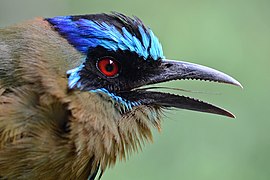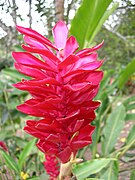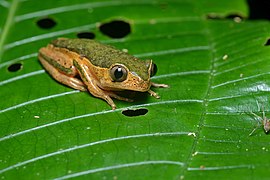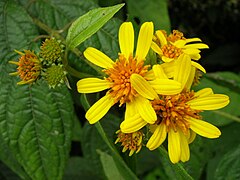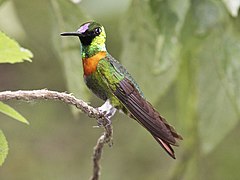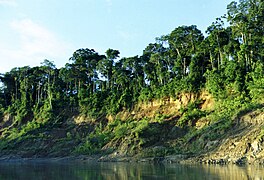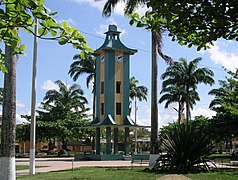Department of Madre de Dios
Madre de Dios is a department of the Republic of Peru with its capital in the city of Puerto Maldonado, located in the southeast of the country, in the Amazon, bordering to the north with Ucayali and Brazil, to the Bolivia to the east, Puno to the south, and Cuzco to the west. With 85,300 km² it is the third largest department —behind Loreto and Ucayali— and with 1.3 inhab/km², the least densely populated. It was created on December 26, 1912 from the territories of Puno and Cuzco.
It receives its name from the Madre de Dios River, from whose basin most of the rivers in the region are tributaries and on whose banks stands the departmental capital: Puerto Maldonado.
From the hierarchical point of view of the Catholic Church, it is part of the Apostolic Vicariate of Puerto Maldonado
Regions
It is located in the high jungle or rupa rupa and in the low jungle or omagua regions.
History
The petroglyphs in the Shinkebeni river (Pusharo Petroglyphs), indicate a very ancient presence of human beings. It is believed that the Arawaks (or their ancestors) arrived in migrations, and many ethnic groups were derived from them. Some tribes, like the Machiguenga, survive to this day. What is known today as Madre de Dios, was part of the ancient Inca Empire, in the region known as Antisuyo. Historians agree that the conquest of this region was difficult for the Incas, since they had to face fierce and knowledgeable tribes of the area. In the area of the Nistron river basin there are also the ruins of Mameria, an Inca settlement, which was discovered in 1979.[citation required]
During the Viceroyalty, Spanish expeditions entered with tragic results for the Europeans. Finally, in 1861, Colonel Faustino Maldonado explored the entire territory and in 1890; Carlos Fermín Fitzcarrald discovered an isthmus that linked the basins of the Ucayali and Madre de Dios rivers. During the following decades numerous adventurers and traders exploited the forests, greedy for rubber and gold. Starting in 1915, with the persistence of the Dominican missionaries, the local tribes began to accept civilization. This has not always been good for them, as tribes like the Harakmbet have abandoned many of their traditional instruments, relying heavily on city dwellers. However, even today there are groups in total physical and cultural isolation.[citation needed]
On December 26, 1912, while Guillermo Billinghurst was President of the Republic, Law No. 1782 was promulgated, approved by the Congress of the Republic, which created the department of Madre de Dios, and assigned it as its capital Puerto Maldonado in recognition of Juan Álvarez de Maldonado, who in 1567 explored the region of the Amarumayo River, today the Madre de Dios River. Likewise, the province of Tambopata with the districts Tambopata, Las Piedras and Inambari are created with this same Law; the province of Manu, with its capital Puerto Manu; and the province of Tahuamanu with its capital Iñapari, which was previously called Puerto Tacna.
At the beginning of the XXI century, Madre de Dios experienced strong economic and demographic growth with the rise of resource exploitation natural, gold mining being the most important activity; but with a strong impact on ecosystems.
Geography
Department entirely jungle; It has areas of high jungle, low jungle and the palm savannah. Part of its geography is rugged, as the Andes plunge into the jungle, forming steep slopes.
- Rivers: Mother of God River, River of Las Piedras, River Manú, River Tambopata, River Tahuamanu and River Heath.
- Abras: Lord of the Miracles (at 540 m. n. m.) in Tambopata; Fitzcarrald (at 469 m. n. m.) in Fitzcarrald.
- Lagunas: Valencia and Sandoval.
Location and boundaries
It limits to the north with Ucayali and Brazil; to the east with Brazil and Bolivia; to the west with Cuzco; to the south with Cuzco and Puno. Its capital, Puerto Maldonado, is at the confluence of the Madre de Dios River and the Tambopata River.
Climate
The climate is tropical, warm, humid, with annual rainfall of more than 1000 mm. The average annual temperature in the capital is 26 °C with a maximum of 38 °C in August and September, on some occasions it can reach 40 °C and a minimum of 21 °C, with rains from December to March. In exceptional years, the territory is invaded by masses of cold air coming from the south during the months of July and August, causing exceptional temperature drops of up to 8 °C in phenomena known as friajes.[citation required]
Fauna and flora
Madre de Dios is home to some of the most biodiverse regions in the world. For example, the Manu National Park holds the record for the number of amphibian and reptile species.
It has an enormous diversity of birds, large species of South American cats (jaguar, tigrillo, puma), multiple species of lizards, and other reptiles such as the boa constrictor and the shushupe. There are also abundant and diverse monkeys, fish, insects and generally groups of animals.
Its flora is also very rich, and among them are species of noble wood and high interest. We can also find many species such as the sanango motelo.
- Biodiversity of Mother of God
Administrative division
This Department has an area of 85,300.54 km² with a population of 140,508 inhabitants, it has 3 provinces and 11 districts:
| Provinces of the department of Mother of God | ||||||
|---|---|---|---|---|---|---|
| Ubigeo | Province | Capital | Districts | Surface km2 | Population 2016 | Altitude m. n. m. |
| 1701 | Tambopata | Puerto Maldonado | 4 | 36 268.49 | 101 787 | 205 |
| 1701 | Manu | Salvation | 4 | 27 835.17 | 24 572 | 527 |
| 1701 | Tahuamanu | Iñapari | 3 | 21 196.88 | 14 149 | 245 |
Demographics
It has a population of 140,000, which represents 0.5% of the national population.[citation required]
Ethnography
The main native communities are: amarakaeri, arasaeri, kishambaeri, pukirieri, sapiteri, toyoeri, wachipaeri, arawak, machiguenga and mashko-piros.[citation needed]
Economy
It concentrates 0.5% of the economically active population - [PEA] and has an economic contribution of 0.4% to the national [GDP]. During 2007 it registered an economic growth of 11.7% compared to 2006 and in the period 2004-2007 the annual growth rate was 8.5%.[citation required]
Its natural resources are abundant: rich woods, wild fruits, precious metals, oil, make the territory as famous as its beauty. In the surroundings of Tambopata are the largest centers of agricultural production, which still work on a small scale.
The crops of coffee, rice, chestnuts, and bread production are essential, as are the raising of cattle and pigs. On the other hand, there are small soda water, soap and plywood industries. There is a thermal power plant: the one in Puerto Maldonado.
In agriculture, rice, rubber, corn, cassava, plantain and coconut stand out. Wood is also a source of income, where mahogany and cedar stand out. Hunting and cattle breeding are practiced. In addition, the gold washes in its rivers give it importance in mining.
Mining is the main economic activity of Madre de Dios. This activity represents 41% of the regional GDP. The region represents 11% of Peruvian gold production.
Gas discovery
The Ministry of Energy and Mines of Peru reported on August 29, 2004 that explorations carried out in this region located in the southeastern jungle of this country, allow projecting the existence of gas with estimates of 32 trillion cubic feet, which which would represent a potential of 960 million barrels of liquid natural gas.[citation needed]
Tourism
Madre de Dios offers a great diversity of flora and fauna in the different areas found in it, such as the Tambopata National Reserve, at the confluence of the Torre and Tambopata rivers, where the richness and variety of birds is amazing; the Manu Biosphere Reserve, made up of the Manu National Park where only anthropological and biological research, observation of life and ecological processes in a natural way are allowed; the Reserved Zone in which tourist and research activities are allowed with minimal manipulation and Bajo Manu, an area in which settler populations who carry out agricultural, livestock and forestry activities predominate, and economic activities are also allowed. The Nisisipi and Sandoval lakes, the Colorado and Pariamanu macaw clay licks, etc. stand out.
Its sunsets are famous,[citation needed] due to the reflection of the snow-capped peaks of the Cusco chain. This atmospheric phenomenon is called "White Lightning". On the other hand, there is the Tambopata-Candamo Nature Reserve, at the confluence of the La Torre and Tambopata rivers, with an area of 5,500 hectares of virgin forest, where the richness and variety of birds reaches 600 species, 900 species of butterflies and 115 species of dragonflies.[citation needed]
The extremely rare maned wolf lives in the Pampas del Heath National Sanctuary. This entire ecosystem had an unalterable evolution for thousands of years, giving rise to one of the greatest varieties of flora and fauna in the world.
For the year 2008, the hotel offer is 2,106 rooms, registering 134,771 national visitors who made 235,892 overnight stays.[citation required]
The places of interest in Madre de Dios are: Manú National Park, Alto Purus National Park, Bahuaja-Sonene National Park, Tambopata National Reserve, Amarakaeri Communal Reserve, Purus Communal Reserve and Pampas del Heath.
- Some tourist destinations of Mother of God
Access routes
- Terrestrial: The most recommended routes are:
- Lima-Arequipa-Juliaca-Puerto Maldonado, (2024 km) with a duration of approximately 38 hours.
- Lima-Nasca-Abancay-Cusco-Puerto Maldonado, (1619 km) with a duration of approximately 32 hours.
- Terrestrial-fluvial: From Cusco to Paucartambo-Salvación (terrestrial), in Boca Manu-Colorado by the river Madre de Dios to Puerto Maldonado (fluvial), the journey lasts approximately 4 days.
- Air: There are flights from the cities of Lima (1.30 hours approx.) and Cusco (45 minutes approximately).
Education
The department of Madre de Dios is home to the National Amazon University of Madre de Dios.
- Public and private schools:
- Total: 305.
- Initial education: 62.
- Primary education: 210.
- Secondary education: 345.
Authorities
Regionals
Like all the other departments of Peru and the Constitutional Province of Callao, it constitutes a de facto region with its own Regional Government as well as an electoral district that elects two congressmen.
- 2019 - 2022
- Regional Governor: Luis Hidalgo Okimura, Alliance for Progress.
- Regional Deputy Governor: Herlens Jefferson Gonzales Enoki, Alliance for Progress.
- Counsellors:
- Tambopata:
- Dany York Celi Wiess (Peru Patria Segura)
- Fatima Pizango Salazar (Alliance for Progress)
- Jorge Luis Díaz Revoredo (Democratic Party We Are Peru)
- Pedro Wanger Cari Rodríguez (Source by Mother of God)
- Wilber Uchupe Flórez (Force by Mother of God)
- Manu:
- Carin Jeraldini Quiroz Miranda (Peru Patria Segura)
- Paul Rufino Sequeiros Bermúdez (Direct Democracy)
- Tahuamanu:
- Jorge Honorato Pita Barra (Alliance for Progress)
- Marcial Tapullima Yuyarima (Peru Libertario)
Religious
Of the Catholic religion:
- Monseñor Francisco González Hernández (Vicar bishop of Puerto Maldonado).
The second most popular and professed religion is the Evangelical, with about 25 churches around the city of Puerto Maldonado, capital of the Department, and approximately 60 churches around the Interoceanic highway Puerto - Iñapari and Puerto Mazuko.
Culture
The Harakmbut prayer song by the Huachipaire ethnic group is part of the cultural expression of Madre de Dios.
Contenido relacionado
Incunabula
Emerald
Anaximander

